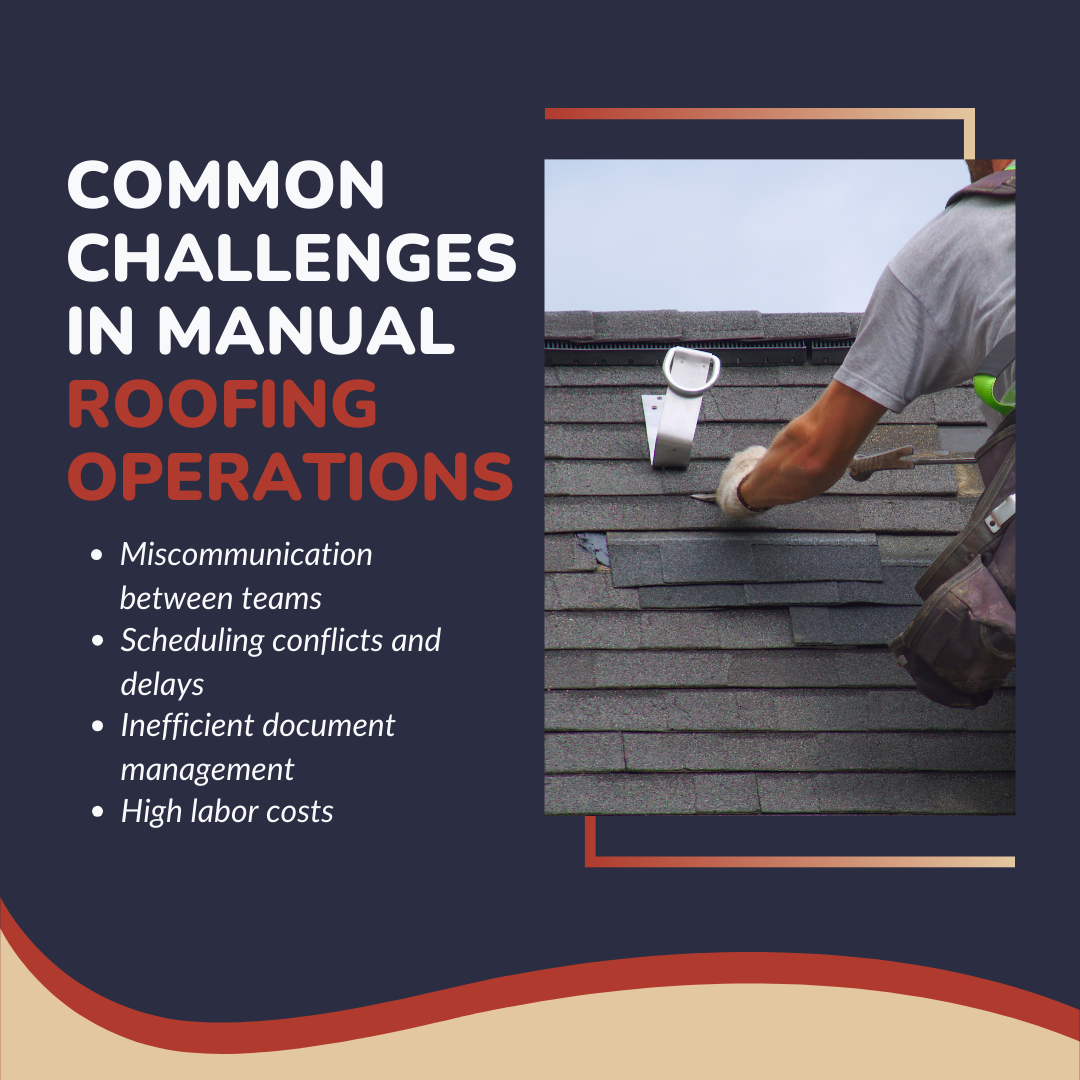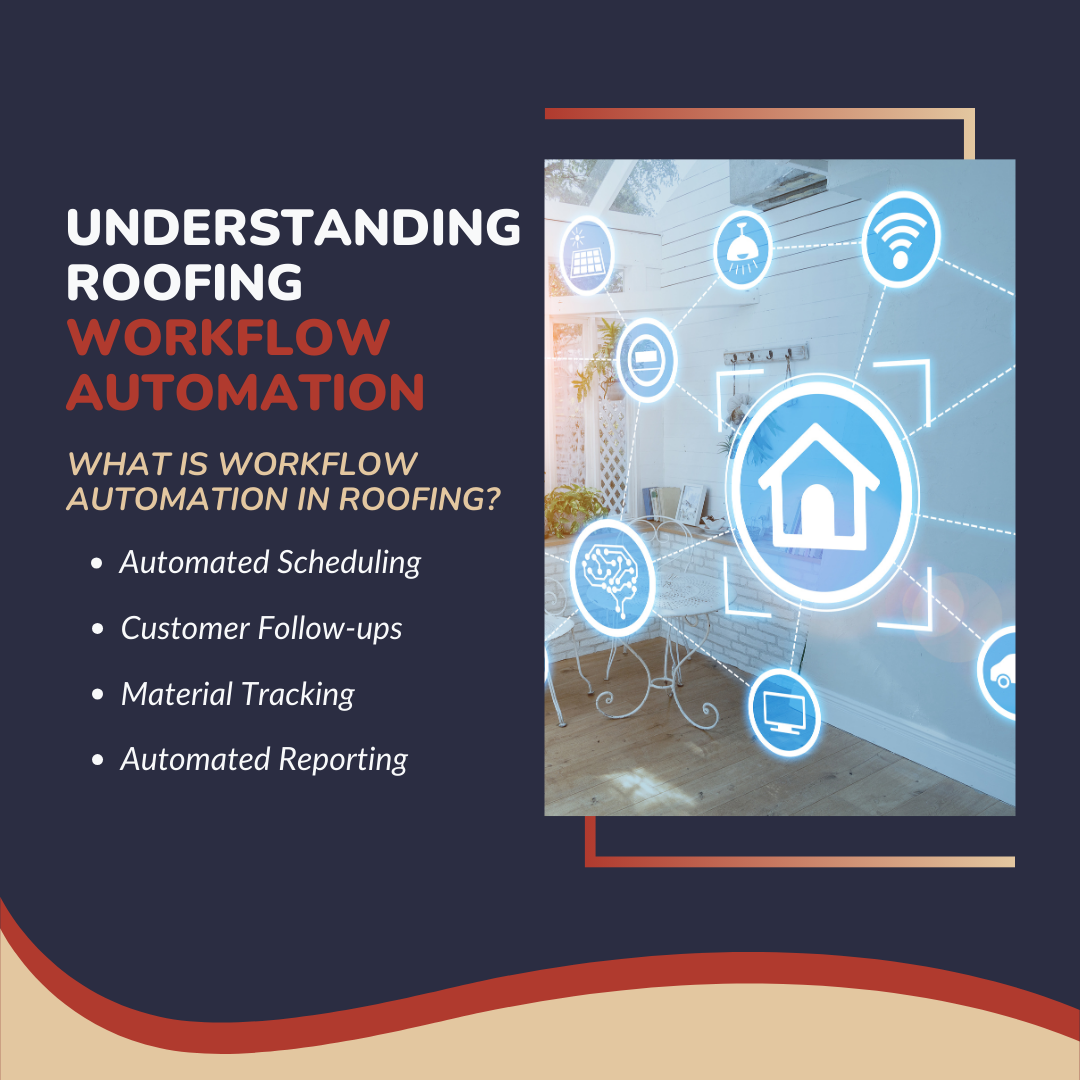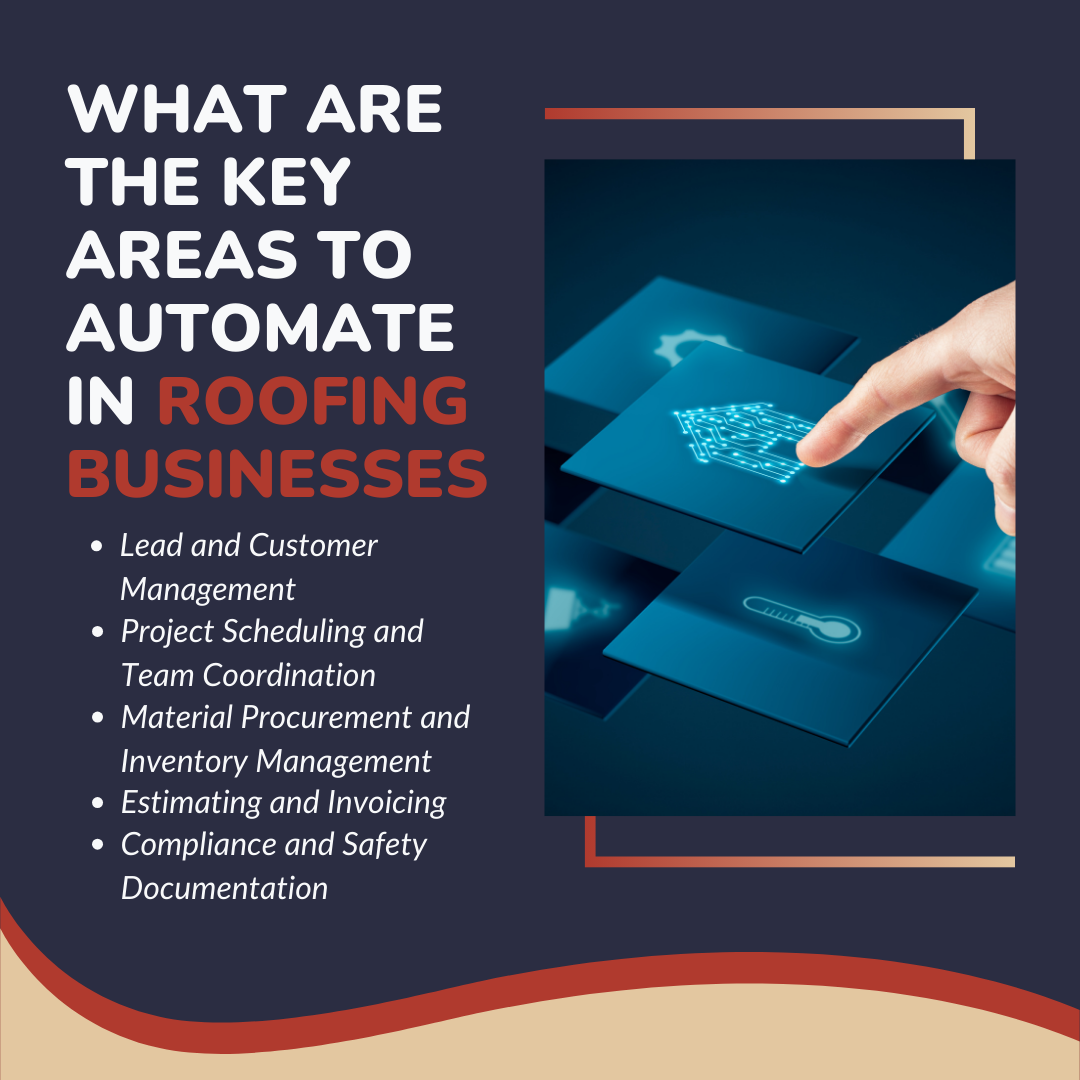April 10, 2025
A study from the Harvard Business Review shows that inefficiencies in workflow processes cost U.S. businesses over $3 trillion every year.
The roofing industry is also not left behind, roofing companies face these same challenges.
The Problems? Outdated roofing CRM software and manual workflow operations, such as spreadsheets, roofing contracts, and phone calls, lead to scheduling errors, missed lead interactions, and profit calculations.
This blog explores how automation addresses roofing business challenges, enhances operations, creates precise estimates, and fosters a scalable model for improved customer satisfaction.
Key takeaways
- Common challenges in the roofing business and their solutions
- How to integrate automation workflow in your roofing business
- Choose the right automation tool for the roofing business
Common Challenges in Manual Roofing Operations

1. Miscommunication between teams
Many roofing contractors and businesses lack effective communication, which is essential in roofing projects involving coordination among roofing contractors, suppliers,
and clients.
Misunderstandings about scope, timelines, quality control, and costs can lead to disputes.
2. Scheduling conflicts and delays
Delays in roofing projects often arise from weather, material shortages, and labor inefficiencies, but poor planning and team coordination are usually the main issues.
These delays can lead to increased costs and strained and unhealthy client relationships.
3. Inefficient document management
Proper documentation is the backbone for construction projects in the roofing business, keeping everyone informed and tracking progress.
However, many projects struggle with poor document management and lack of valuable data leading to lost documents, version issues, and retrieval problems.
These challenges can cause delays, mistakes, missed closing deals, and legal disputes.
4. High labor costs
Labor costs constitute a significant portion of expenses in roofing projects. Factors contributing to high labor costs include:
- Rework Due to Errors: Mistakes from miscommunication mean doing the same work again, adding extra labor hours and costs.
- Inefficient Workflows: Slow or unorganized processes make tasks take longer than necessary, increasing labor expenses.
- Skilled Labor Shortages: The roofing industry often struggles to find skilled workers. This leads to higher wages and increased training costs.
Addressing these challenges through effective customer communication, strategic planning, resource allocation, efficient documentation management, and streamlined workflows is essential to enhance operational efficiency and profitability.
Understanding Roofing Workflow Automation

What is Workflow Automation in Roofing?
Workflow automation in roofing means using software to handle tasks like lead management, project coordination, invoicing, and team communication automatically.
How Does It Work?
1. Automated Scheduling:
Roofing businesses can automatically assign tasks, track progress, and minimize delays.
2. Customer Follow-ups:
AI-driven tools ensure timely reminders and engagement with potential clients.
3. Material Tracking:
Inventory is updated in real-time to avoid shortages or over-purchasing.
4. Automated Reporting:
Roofing software provides key performance indicators (KPIs) to help businesses make data-driven decisions.
This reduces manual work, saves time, and ensures smooth operations, helping roofing companies work faster, keep customers satisfied, and grow their business.
Also read: How a Roofing CRM Can Transform Your Business Operations
What are the Key Areas to Automate in Roofing Businesses

1. Lead and Customer Management
Imagine this: A homeowner contacts your roofing company to enquire about the expenses needed for planning and execution. You jot down their details on a notepad, intending to follow up, but things get busy, and a week later, they’ve already hired a competitor. Sound familiar?
The Problem:
- Leads are lost because of disorganized follow-up processes.
- Roofing businesses rely on manual tracking methods (sticky notes, spreadsheets, etc.), leading to the loss of customer data.
- Slow response times frustrate potential clients, making them look elsewhere.
How Automation Helps:
CRM software (Customer Relationship Management) automatically captures leads from your website, emails, and phone calls so no potential client is forgotten.
- Automated follow-ups and automated messaging via text and email ensure customers receive timely responses.
- Lead scoring prioritizes high-quality service-value clients so your sales team focuses on the most profitable opportunities.
- Stores all customer data in one place, ensuring nothing gets lost.
Must read: Best Roofing Software for Customer Management in 2025
2. Project Scheduling and Team Coordination:
Say bye to the chaos
Have you ever had a roofing project delayed because of a double booking? Roofing schedules can be a nightmare to manage manually, especially when dealing with unpredictable weather, subcontractors, and emergency repairs.
The Problem:
- Miscommunication between office staff and field teams leads to delays.
- Manually assigning jobs is time-consuming and prone to scheduling conflicts.
- Lack of informed decisions and waiting for project details slow down productivity.
How Automation Helps:
- Auto-assign jobs based on availability and location, ensuring the right team is at the right site.
- Mobile access for field teams so that they can check schedules, get updates, and upload project photos on the go.
- Calendar syncing with Google or Outlook helps prevent double bookings and scheduling errors.
3. Material Procurement and Inventory Management:
No More Last-Minute Rush to the Supplier
Picture this: You’re halfway through a big roofing job when you realize you’re out of materials. Now, you have to make an emergency run to the supplier, delaying the project and frustrating the customer.
The Problem:
- No real-time tracking of inventory, leading to stockouts or over-ordering.
- Manual purchasing decisions result in unnecessary costs.
- Delays in ordering materials cause project hold-ups.
How Automation Helps:
- AI-powered forecasting predicts material needs based on past projects, preventing shortages.
- Automated reordering ensures supplies are stocked before they run out.
- Real-time inventory tracking helps you monitor usage and avoid over-purchasing.
4. Estimating and Invoicing:
Let’s be honest, no one enjoys the paperwork side of roofing. Creating estimates, drafting proposals, and chasing payments can eat up hours of your time. Worse, if there’s a miscalculation, you risk overcharging (and losing a customer) or undercharging (and losing money).
The Problem:
- Manually calculating estimates takes too long and is prone to errors.
- Slow invoicing delays payments, affecting cash flow.
- Paper-based proposals look unprofessional and can get lost.
How Automation Helps:
- Auto-generate accurate estimates using templates and AI-driven cost calculations.
- Automated invoicing & payment reminders speed up collections, ensuring you get paid on time.
- Instant proposal creation allows you to send professional proposals and quotes within minutes.
5. Compliance and Safety Documentation:
Stay Legally Compliant Without the Paperwork Headache
Every roofing project comes with safety regulations, permits, and inspections, and failing to stay compliant can result in costly fines or legal trouble.
But keeping up with paperwork manually? That’s a nightmare.
The Problem:
- Safety checks are forgotten or missed when done manually.
- Lost or misplaced documents make it hard to prove compliance.
- Permit applications take too long, delaying project timelines.
How Automation Helps:
- Digital safety checklists ensure complete inspections before starting work.
- Cloud storage for documents makes compliance records easily accessible anytime.
- Automated permit applications streamline approval processes.
- Incident reporting automation allows real-time submission of accident reports.
Implementation: How to Integrate Automation into Your Roofing Business Growth

1. Identify Problem Areas
Pinpoint bottlenecks like missed follow-ups, scheduling conflicts, manual data entry, or delayed invoicing. Prioritize what’s slowing you down.
2. Choose the Right Automation Tools
- CRM for Lead and Customer Management – Track interactions and automate follow-ups.
- Scheduling and Project Management – Assign jobs and monitor progress in the entire process in real-time.
- Estimating and Invoicing – Auto-generate quotes and streamline payments.
- Inventory Management – Prevent material shortages with AI-powered tracking.
3. Start Small and Scale Up
- Test automation in one area first (e.g., invoicing).
- Train your team to use the right accounting software tools effectively.
- Monitor results and expand automation gradually.
4. Keep Your Team Involved
- Discuss workflow challenges with employees.
- Gather feedback and make necessary adjustments.
- Ensure automation complements, not replaces, human and automated workflows.
5. Track Success and Optimize
Monitor key metrics like lead conversion, project timelines, customer satisfaction, and revenue growth. Adjust systems as needed for continuous improvement.
How Rooferbase Transform Your Business?
Rooferbase is a powerful, all-in-one, roofing software and automation platform designed for roofing businesses. Let's see why:
- Lead and Customer Management: Track leads, automate follow-ups, and close deals faster.
- Project Scheduling and Team Coordination: Assign tasks, monitor progress, manage projects, and prevent delays.
- Material and Inventory Management: AI-powered forecasting ensures you never run out of supplies.
- Estimating and Invoicing: Auto-generate quotes and invoices for faster payments.
- Compliance and Safety Documentation: Digitize safety checks and permit applications effortlessly.
By automating these key areas, Rooferbase helps you cut down on manual work, boost efficiency, and further enhance productivity and customer satisfaction, all while growing your business.
Conclusion
Automation isn’t just a tech upgrade, it’s a long-term investment in efficiency, profitability, and customer satisfaction. Implement it wisely, and watch your roofing business thrive.
The best part? These tools don’t replace your team; they empower them, allowing them to work smarter, not harder.
If you’re ready to scale and simplify your business, automation is the way forward.
About Rooferbase
Streamline operations by reducing manual workload, improving customer satisfaction, and increasing profitability. All with Rooferbase!
Take control of your roofing business with Rooferbase. Schedule your demo today!
FAQs
1. How can automation help my business grow?
It saves time, reduces errors, and improves sales process and customer satisfaction, leading to more revenue.
2. Is Rooferbase easy to use for roofing teams?
Definitely! It’s designed for roofing professionals with a simple, intuitive interface and mobile access.
3. Is workflow automation only for large roofing companies?
No! Automation benefits businesses of all sizes by improving efficiency, whether you're a small team or a large operation.






